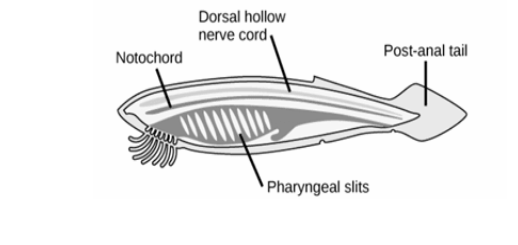The term “chordate” refers to any animal that belongs to the phylum Chordata and is classified as such. As described by the International Union of Natural Sciences and Mathematics, Chordates are “animals that possess four anatomical traits, namely a notochord, a dorsal nerve cord, a post-anal tail, and pharyngeal slits, at least throughout some stage of their development into maturity.” Chord comes from the Latin chorda, which literally translates as “cord” or “string.” Chordate is a slang term for the word chordate.
Chordate Characteristics
This phylum’s members have four distinguishing characteristics: a notochord, a dorsal hollow nerve cord, pharyngeal slits, and a post-anal tail.

Notochord
The notochord is a flexible rod that runs parallel to the organism’s anteroposterior axis (i.e. from top to bottom). It is located dorsal to the intestines and ventral to the body’s central nervous system.
Indeed, the chordates get their name from the notochord. This adaptable and rod-shaped structure may arise during chordate development or may continue until maturity. Chordates with a persistent notochord rely on it for skeletal support. The notochord is replaced by the vertebral column (spine) in other chordates, such as vertebrates, when they have completed their embryonic development.
The notochord is a structure that lies between the nerve code and the gastric tube. It is primarily engaged in signalling, but also plays a critical function in the coordination of growth and development in vertebrates. The vertebrate notochord, in particular, promotes neural tube formation. Notogenesis is the term used to describe the developmental process.
The dorsal hollow nerve cord
The dorsal hollow nerve cord is a hollow tube that develops from the ectoderm during the vertebrate embryonic stage. It is located posterior to the notochord. Thus, it is visible at the top of the chordates’ notochord. This tube is composed of nerve fibres that eventually evolve into the central nervous system, which is mostly composed of the brain and spinal cord. The dorsal hollow nerve cord is safeguarded by the vertebral column.
However, the nerve cord is not a unique characteristic of chordates. It is also found in other phyla of animals. In other animals, it is ventral or laterally placed, in contrast to chordates, where it is dorsal to the notochord.
Pharyngeal slit
The pharyngeal slits are the apertures in the pharynx, i.e. the area below the mouth (or oral cavity) that extends to the outside (environment). Chordates, which are invertebrate chordates, use these pores for filter feeding. Water enters the mouth through the pharyngeal slits, filtering food particles as it departs. Pharyngeal slits eventually develop into gill supports or jaw supports in aquatic animals such as fish (as in jawed fishes). In other animals, such as mammals and birds, the pharyngeal slits are present at the embryonic stage and eventually merge into the ear and tonsils as separate structures.
Post-anal tail
The post-anal tail is the posterior extension of the body that extends beyond the anus. The post-anal tail of aquatic chordates contains skeletal components and muscles and is thus critical for the organism’s mobility in its aquatic habitat. By definition, locomotion refers to an organism’s ability to move from one location to another. Animals locomote in a variety of ways. These include running, swimming, leaping, flying, and hopping. The post-anal tail, for example, is critical in permitting fish movement. The tail is employed by terrestrial chordates for balance and signalling. This tail is vestigial in humans and apes, meaning it is present during embryonic development but diminishes in size or becomes nonexistent at birth.

Animals Do Not Have Backbones
Sponges, corals, worms, insects, spiders, and crabs are all classified as invertebrate animals since they lack a backbone. Fish, reptiles, birds, amphibians, and mammals are all classified as vertebrates since they all have internal skeletons and backbones.
Conclusion
A phylum of the animal kingdom composed of all creatures that have a notochord (a hollow dorsal nerve cord), pharyngeal slits, and a muscular tail extending beyond the anus at some point in their lives. The subphyla Cephalochordata, Urochordata, and Vertebrata are all included in this classification system (vertebrates).
 Profile
Profile Settings
Settings Refer your friends
Refer your friends Sign out
Sign out






